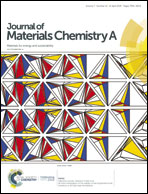Cu3P as a novel cathode material for rechargeable aluminum-ion batteries†
Abstract
Rechargeable aluminum-ion batteries (AIBs), using a room temperature ionic liquid as the electrolyte and metallic Al as the anode, are very promising alternatives for large-scale electricity storage due to abundant aluminum sources, their high specific capacity, and their high safety. Cathode materials with both high capacity and low cost are of great importance for the achievement of such applications. Herein, copper phosphide (Cu3P) which is synthesized via a high-energy ball milling method is utilized for the first time as a novel cathode material for AIBs. It delivers high initial charge and discharge capacities of 139.1 and 73.8 mA h g−1 at 50 mA g−1, respectively, but shows poor cycling performance. After coating with acetylene black, the Cu3P/C composite exhibits a dramatically enhanced cycling stability. The charge–discharge mechanism of Cu3P is investigated using ex situ X-ray diffraction and X-ray photoelectron spectroscopy, which show that AlCl4− anions intercalate into Cu3P in the initial charge process, leading to the oxidation of Cu and P species. In the discharge process, the valence of the oxidized Cu remains unchanged while P is partially reduced. These findings are of great significance for the fundamental understanding of the Cu3P cathode for AIBs, as well as the further development of novel cathode materials of AIBs.



 Please wait while we load your content...
Please wait while we load your content...